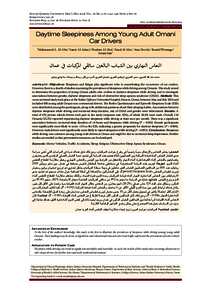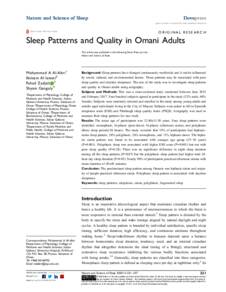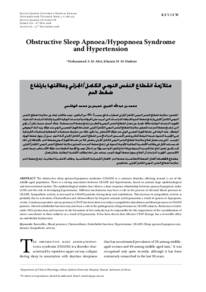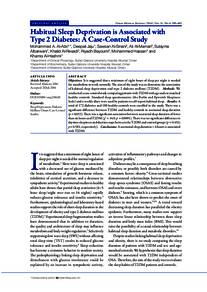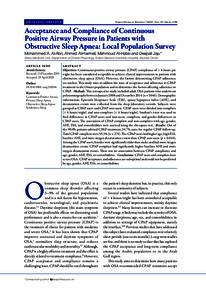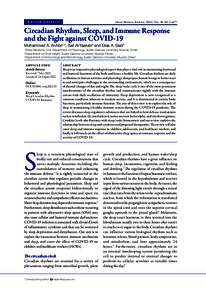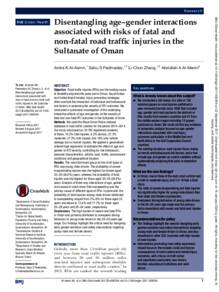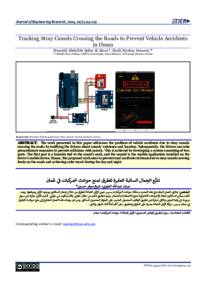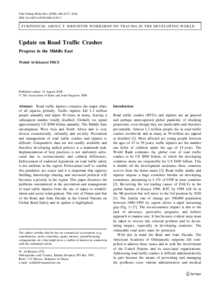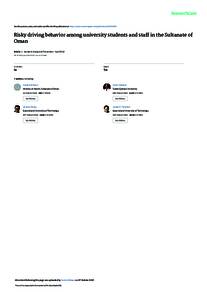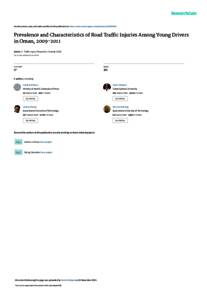Document
Daytime sleepiness among young adult Omani car drivers.
Contributors
Other titles
النعاس النهاري بين الشباب البالغين سائقي المركبات في عمان
Publisher
College of Medicine, Sultan Qaboos University.
Gregorian
2018-05
Language
English
English abstract
to determine the proportion of young Omani adults who confess to daytime sleepiness while driving and to investigate associations between gender, daytime sleepiness and risk of obstructive sleep apnoea syndrome (OSAS). Methods: This cross-sectional study took place at the Sultan Qaboos University Hospital, Muscat, Oman, between May and July 2014 and included 600 young adult Omani non-commercial drivers. The Berlin Questionnaire and Epworth Sleepiness Scale (ESS) were distributed among the participants, along with additional questions about their sleeping habits. Associations between daytime sleepiness while driving and nocturnal sleep duration, risk of OSAS and gender were determined. Results: A total of 492 private vehicle drivers took part in the study (response rate: 82%), of which 50.4% were male. Overall, 124 Omanis (25.2%) reported experiencing daytime sleepiness while driving at least once per month. There was a significant association between nocturnal sleep duration of <6 hours and sleepiness while driving (P = 0.042). Female participants were significantly more likely to score >10 on the ESS, indicating a greater propensity for daytime sleepiness (P = 0.006). However, male drivers were significantly more likely to report sleepiness while driving (P = 0.001). Conclusion: Sleepiness while driving was common among young male drivers in Oman and might be due to nocturnal sleep deprivation. Further studies are needed so that preventative measures can be developed.
Member of
Resource URL
Citation
Al-Abri, Mohammed A., Al-Adawi, Samir, Al-Abri, Ibrahim, Al-Abri, Faisal, Dorvlo, Atsu, Wesonga, Ronald, & Jaju, Sanjay (2018). Daytime Sleepiness Among Young Adult Omani Car Drivers. Sultan Qaboos University Medical Journal, 18 (2), e143–148.
Arabic abstract
يعتبر النعاس والإرهاق سبباً رئيسياً في وقوع حوادث المركبات، ومع ذلك، فإن هناك ندرة في الدراسات التي تعنى بدراسة مدى انتشار النعاس أثناء قيادة المركبة بين العمانيين، لذلك هدفت هذه الدراسة إلى تحديد نسبة الشباب العماني الراشدين الذين يعترفون بإصابتهم بالنعاس أثناء القيادة فترة أثناء النهار وللتحقق من الترابط بين الجنس والنعاس النهاري وخطر متلازمة انقطاع التنفس أثناء النوم. الطريقة: أجريت هذه الدراسة المستعرضة في مستشفى جامعة السلطان قابوس بمسقط في عمان بين مايو ويوليو 2014 وشملت عدد 600 من السائقين العمانيين الشباب الغير عاملين في مهنة سياقة المركبات بشكل تجاري، تم توزيع استبيان برلين ومعيار إبورث لمقياس النعاس pworth Sleepiness Scale على المشاركين، بالإضافة إلى أسئلة إضافية حول عادات نومهم، تم تحديد مدى الارتباطات بين النعاس أثناء فترة النهار أثناء قيادة المركبات ومدة النوم فترة المساء، وكذلك مخاطر متلازمة انقطاع التنفس أثناء النوم ونوع الجنس النتائج: شارك في الدراسة ما مجموعه 492 من سائقي المركبات الخاصة (معدل الاستجابة %82) ، منهم %50.4% من الذكور، وبشكل عام، أفاد 124 شاب عماني (%25.2) أنهم يعانون من النعاس خلال النهار أثناء القيادة مرة واحدة على الأقل كل شهر وكان هناك ارتباط كبير بين مدة النوم الليلي الأقل عن 6 ساعات والنعاس أثناء قيادة المركبة (0.042) ، كما كانت المشاركات من الإناث أكثر احتمالا بكثير في تسجيل معدل أكثر من 10 حسب معيار إبورث لمقياس النعاس، مما يدل على زيادة الميل للإصابة بالنعاس أثناء فترة النهار (0.006 - P. ومع ذلك، كان السائقون الذكور أكثر عرضة للإبلاغ عن النعاس أثناء القيادة (0.001 - P). الخلاصة: كان النعاس أثناء القيادة أمراً شائعاً بين السائقين الشباب الذكور في عُمان وربما يعود ذلك إلى نقص النوم أثناء فترة الليل هناك حاجة إلى مزيد من الدراسات حول هذا الموضوع حتى يمكن وضع التدابير الوقائية اللازمة.
Category
Journal articles

